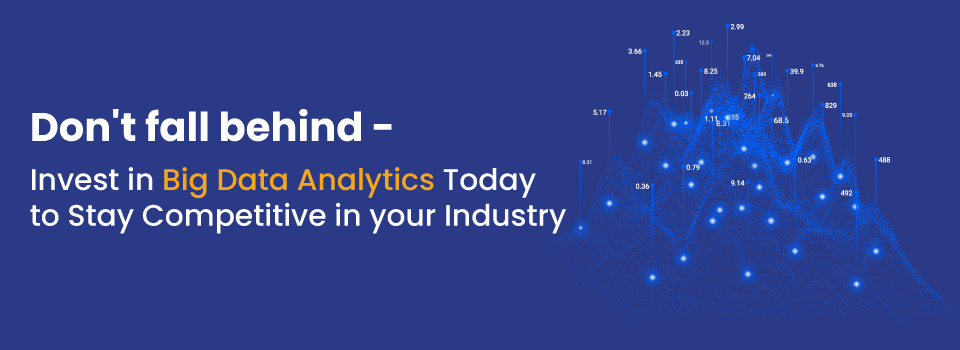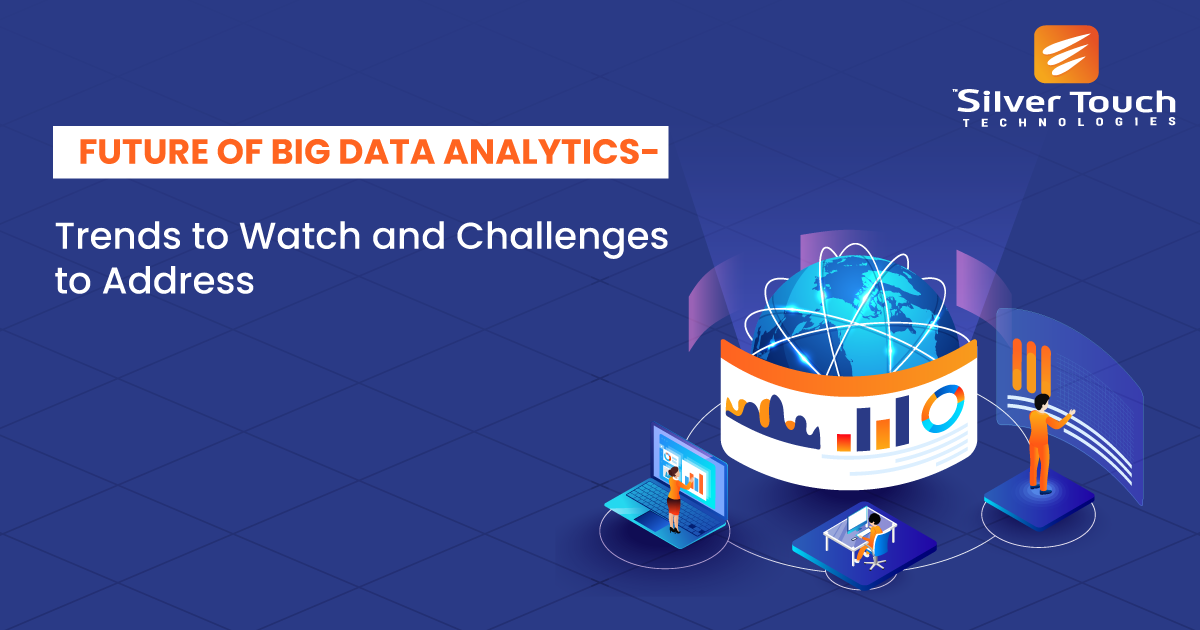Big data analytics has emerged as a promising approach for modern industries. Every organization tends to leverage its benefits to stay ahead of their competitors. As per the official report, over 2.5 quintillion bytes of data are created daily, and in the last couple of years, we have got 90 percent of all the data in the world. Most enterprises consider big data as their crucial asset to grow. It is interesting to jot down key big data analytics trends in such a scenario.
In this post, we will discuss the future of big data analytics with its major trends and challenges. Let’s understand what lies ahead for this revolutionary approach.
Predictions for Big Data Analytics for 2023
Future Big data analytics trends have a basis of multiple predictions and expectations.
Here are some key predictions that will play a vital role in deciding the future direction of Big data analytics.
- These trends should enable enterprises to predict changes and manage possible uncertainties.
- Companies should invest in trends that meet their long-term goals and accelerate growth.
- A competitive business scenario requires deep market analysis, and all the Big data analytics trends should meet this requirement.
- Analysis of global markets is essential across different aspects including market drivers, limitations, and technological advancements.
- Proactive monitoring and strategic investment in Big data analytics are essential to get the desired outcome.
Let's go through the latest trends of Big data analytics based on the above expectations.
Seven Trends Shaping Big Data Analytics for 2023
Quote
"Information is the oil of the 21st century, and analytics is the combustion engine."
Peter Sondergaard
The 5 V's of big data- velocity, value, volume, variety, and veracity are its innate characteristics that drive its future. We witness the positive impact of big data on modern businesses, but it is imperative to keep this technology up to date to maintain its efficiency. Here are the biggest and most promising big data analytics trends that can help companies achieve some common goals and improve business models in the complex corporate world.
1. Rise of Edge Computing
In layman's terms, edge computing is the processing of data at the edge of a network or device instead of a centralized location. The ever-increasing popularity of Internet of Things (IoT) devices drives the growth of this concept. It is fairly difficult to manage all the data from a centralized location if many connected devices work simultaneously. In such a scenario, businesses find edge computing useful and cost-effective. The third-party networks are capable of handling edge computing and can be combined with analytics through IoT edge analytics tools.
Edge computing can reduce the need for data to flow through multiple networks and thereby optimizing the performance and storage. It also reduces computing and processing rates more effectively than cloud computing. This concept is gaining ground for accelerating data analysis and offering quicker responses to users.
2. Prevalence of Cloud
Cloud computing is here to stay. Though it has some limitations and does not remain an ideal option for storing highly sensitive data, companies tend to prefer it to get many benefits. These days, businesses tend to focus on who has access to the corporate information rather than what is stored in the cloud.
In other words, privacy concerns and data security loom large these days, but big data analytics has a solution for these challenges of cloud computing. A big data services provider can assist companies to save their data in the cloud in line with the existing regulations and standards. Shared SaaS companies can address data privacy concerns with the help of big data analytics.
3. DataOps is in Focus
DataOps is one of the practices that primarily focuses on agile approaches while dealing with a full data cycle. DataOps processes address organizational requirements directly across the entire data lifecycle without considering people and data generation processes.
In a way, dataops tends to transform the data cycle from generation into insights. In a way, the concept can make big data analytics more powerful and effective.
4. Penetration of AI and ML
Deeper penetration of both AI and ML will make big data analytics more robust, reliable, and customer-centric than ever. AI is already in use by big and small organizations to improve their business processes. In the recent survey of Enterprise Strategy Group on spending intentions, around 63% of the 193 respondents said they expected their organizations to spend more on AI and ML in 2023.
Machine learning enables organizations to detect anomalies in large data sets and offers other advanced data analysis capabilities including image and video or text recognition systems, automation of data classification, and personalized recommendations in products and services.
Big data analytics systems can find optimal solutions to business problems, and both AI and ML technologies facilitate companies to provide their customers with better support in a personalized way. As a vital part of big data, ML can process and analyze a plethora of information in a fraction of second.
5. Advancement of Data Lakes
Ever-increasing amount leads to a new type of architecture known as data lakes. Traditionally, organizations were used to store their data in a relational database, but the problem with this type is it is highly structured and that makes the storage of different types of data cumbersome. Data lakes facilitate companies to keep all types of data in one place. This approach can readily combine with big data analytics also and entrepreneurs can get real-time, accurate insights.
6. Prevalence of Data Fabrics and Data Governance
A data fabric is a framework and a collection of data services that standardizes best practices of big data. It also offers consistent functionality in hybrid multi-cloud systems. Data Fabric can share data across different platforms and applications without using any additional third-party tools or software.
Another major trend is data governance. We can mention many reasons for the advent of a more restrictive data governance in the future. The first reason is the need for data protection and privacy regulations. Second reason is an increasing demand for making data-driven decisions that require more transparency.
7. Adoption of Predictive Analytics
Predictive analytics has been around us for a long time. It is one of the top benefits of the concept of big data. In the future, organizations will widely use this concept to understand the customer's behavior and expectations along with their reaction to a specific event, product, or services.
For example, the BFSI sector can use predictive analytics based on big data to identify credit card fraud or to predict which customers are likely to default on their loans.
Other big data future trends include deep learning and the evolution of streaming analytics with the advent of advanced security tools.
Impact on industries
Healthcare, retail, manufacturing, banking & finance, transportation & logistics, etc. are some of the core industry sectors that witness a significant impact of big data analytics.
As the big data phenomenon determines the current data-driven scenario, its impact on business keeps on increasing.
As per a NewVantage Partners survey, over 98% of leading companies confirm investment in AI and big data capabilities. (Source) Also, an IDC report has expected that big data and business analytics revenue will reach $274.3 billion worldwide by 2022. (Source)
Here we mention three major areas where enterprises get the maximum impact of big data analytics.
Quality
As modern companies permanently seek competitive advantages, big data helps companies with more precise and powerful target marketing through advanced analytics and improved decision-making. It offers multiple ways of improving the quality of products and services.
Cost
Repetitive tasks take a lot of time and effort of any enterprise. AI projects based on big data can automate these tasks while streamlining workflows. With big data analytics, enterprises can free employees to focus more on other productive activities and save costs.
Analytics
It is the industry's major aspect with significant impact. Big data enables you to leverage the advantage of data visualization. You can get a bigger picture and the context can get additional power through big data. As a result, you can get better predictions over the period.
Big data future trends offer not only economic but also social benefits to various industry sectors.

Key Challenges for Shining Future of Big Data Analytics
Future of big data analytics largely depends on advancing technology and the ways of addressing core challenges of big data. Some of the most common big data challenges include-
Storage
It is one of the biggest challenges for organizations that generate vast amounts of data on a daily basis. If the data is in different formats then it is difficult to store it within legacy and unstructured systems.
Process
Big data processing involves reading, extracting, transforming and formatting of useful information from raw data. When the information is in unified format, it can create difficulties during input and output.
Data Security
It is one of the biggest concerns for entrepreneurs. Any non-encrypted information is always at risk of theft or damage by hackers or cyber-criminals. Therefore, data security professionals have to maintain strict security protocols.
Healthcare Challenges
The healthcare sector faces challenges in preventing electronic health records (EHRs), genomic sequencing, lab reports, wearables, and medical imaging of patients from going into the wrong hands.
Security Management Challenges
It is essential to follow all the data and analytics procedures to prevent both online and physical threats. Some of the security-related threats include denial-of-service (DoS) assaults, data theft, ransomware, and other malicious activities.
Big data analytics trends will focus on addressing these challenges while maintaining data security.
Concluding Remarks
The market of big data analytics is growing at a rapid pace as businesses invest millions of dollars to leverage the benefits of valuable information. Integration of AI, ML, data sharing, and other innovative concepts will make big data analytics more powerful and effective than ever. A reliable partner can help your company get an advantage of big data future trends by addressing its major challenges efficiently.
Silver Touch Technologies is a renowned big data analytics company that uses technological advancements and assists corporate clients to unleash the potential of big data. We ensure optimization of key business operations with our robust and future-ready big data analytics solutions.
Do you want to know more about our services and propositions in Big Data? Simply drop us a line at info@silvertouch.com and we will get back to you soon.



